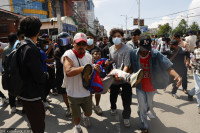Editorial
Fighting for breath
Nepal needs to develop national guidelines to tackle pneumonia.
Pneumonia—an infection affecting the lungs—is a common, yet, deadly disease. Despite progress, it continues to be the leading cause of child mortality in Nepal. The most common symptoms of pneumonia are cough, fever ranging from mild to high, shaking chills and shortness of breath. Reportedly, the disease kills more children annually than malaria, tuberculosis and HIV combined. Its treatment is not easy on the pockets either. The average cost of hospitalisation per family is Rs13,250—as good as half the average Nepali household’s monthly expenses. The disease, unfortunately, takes a heavy toll that leaves vulnerable children struggling, parents coping with anxiety and the expenses. What’s more, there is grief and trauma that comes with the loss. This is concerning.
According to the World Health Organisation, out of the total under-five mortality rate, 15 percent die of pneumonia in Nepal. But the data of the Health Management Information System under the Department of Health Services reveals that about 30 percent of children under five died of pneumonia in the country. Such discrepancy in the statistics is problematic, too. It is imperative to standardise the recording and reporting mechanism at the national, state and sub-state levels so that the results do not vary. As long as different reports produce different results, one can never have a clear picture to come up with appropriate and tailor-made solutions to deal with the problem.
Vaccines have played an immense role in contributing to global health. They have helped protect children from serious diseases such as pneumonia, diarrhoea, measles, and polio. Around the world, and in Nepal, too, vaccines have drastically reduced the number of children who die, fall sick or need to be hospitalised. Since immunisation is the core intervention to reduce child mortality, the government has made it amongst its core priority programmes. In the case of pneumonia too, kids immunised with pneumococcal conjugate vaccine do not contract pulmonary infections. In fact, according to a report published by Save The Children in 2016, 170 million children under the age of two in the developing countries are unimmunised.
Pneumonia is a preventable disease. But oftentimes, in rural areas, basic things like not being able to receive prompt attention at health care facilities have made children vulnerable to the disease.
Nepal needs to develop comprehensive national guidelines and multi-sectoral convergent action plans to tackle pneumonia and ensure adequate resourcing for implementation at the local, provincial and federal levels. These plans should be supplemented by an increased budget allocation for health. What’s more, the need to strengthen primary healthcare and facility-based pediatric services by investing in infrastructure, equipment, skilled health personnel and addressing supply chain gaps cannot be overestimated.




 8.12°C Kathmandu
8.12°C Kathmandu














